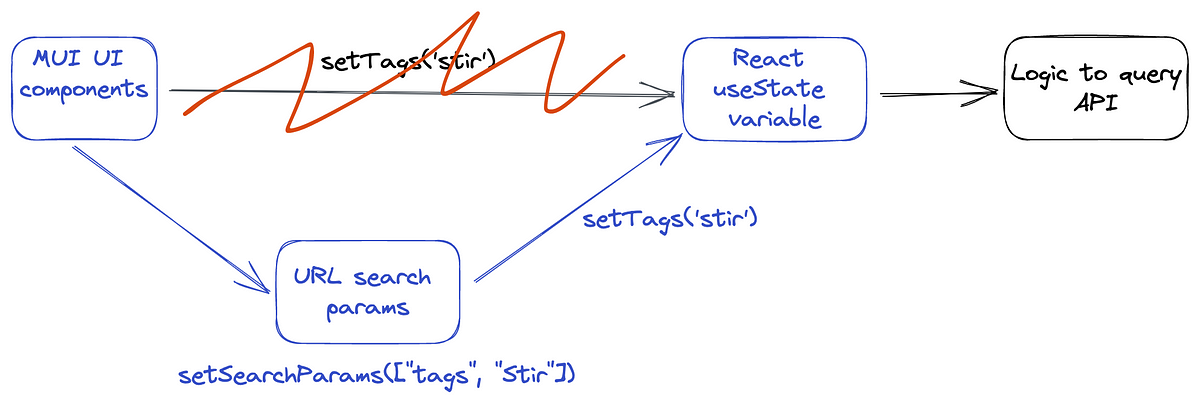NextJS URL Parameters: Guide to Dynamic Routing
Learn how to use URL parameters in Next.js for dynamic routing and data fetching, similar to React Router.
Learn how to use URL parameters in Next.js for dynamic routing and data fetching, similar to React Router.
This article explains how to work with URL parameters in Next.js, covering dynamic routes, accessing parameters, programmatic navigation, query parameters, URL state in the App Router, and important considerations like data fetching and client-side routing.
Next.js provides a file-system based router that makes handling dynamic routes and URL parameters straightforward. Here's a breakdown of how to work with them:
1. Defining Dynamic Routes:
File Structure: Create a folder and file within your pages directory that represents the dynamic segment of your URL. For example, to handle URLs like /users/123, you would create:
pages/
users/
[id].js
The [id].js File: This file will handle all requests that match the /users/ pattern followed by any value. Inside this file, you can access the dynamic segment (123 in our example) using the useRouter hook.
import { useRouter } from 'next/router';
function UserDetailPage() {
const router = useRouter();
const userId = router.query.id;
return (
<div>
<h1>User Details</h1>
<p>User ID: {userId}</p>
</div>
);
}
export default UserDetailPage;2. Accessing URL Parameters:
useRouter Hook: The useRouter hook from next/router provides access to the query object, which contains all the dynamic segments of the current URL.
import { useRouter } from 'next/router';
function MyComponent() {
const router = useRouter();
const { id, category } = router.query;
// ... use id and category
}3. Programmatically Navigating with Parameters:
push Method: You can programmatically navigate to dynamic routes using the push method of the useRouter hook.
import { useRouter } from 'next/router';
function MyComponent() {
const router = useRouter();
const handleClick = () => {
router.push(`/users/456`);
};
return (
<button onClick={handleClick}>Go to User 456</button>
);
}4. Query Parameters:
Appending to URLs: To add query parameters like ?search=term, you can append them directly to the URL string when using router.push.
router.push(`/products?search=shoes&category=men`);Accessing Query Parameters: You can access query parameters just like dynamic segments, using the router.query object.
const { search, category } = router.query;5. URL State (App Router):
Passing State with push: In the App Router, you can pass state along with the URL using the push method's second argument.
router.push('/dashboard', { state: { name: 'John' } });Accessing State: Access the passed state using router.state.
const { name } = router.state;Important Notes:
getServerSideProps or getStaticProps for this purpose.By mastering these techniques, you can effectively manage dynamic routes and URL parameters in your Next.js applications, creating dynamic and user-friendly experiences.
This code is a Next.js application demonstrating URL parameters. It includes a homepage with links to dynamic product and user pages. The product page displays product details based on the productId and an optional color query parameter. The user page shows the userId and has a button that programmatically navigates to a specific product page with a query parameter. The example uses dynamic routes, the useRouter hook to access query parameters, and demonstrates programmatic navigation.
This example showcases how to define dynamic routes, access URL parameters, and navigate programmatically in a Next.js application.
Project Structure:
pages/
index.js
products/
[productId].js
users/
[userId].js
1. pages/index.js (Homepage):
import Link from 'next/link';
export default function Home() {
return (
<div>
<h1>Homepage</h1>
<ul>
<li>
<Link href="/products/1?color=red">Product 1 (Red)</Link>
</li>
<li>
<Link href="/users/john-doe">User John Doe</Link>
</li>
</ul>
</div>
);
}2. pages/products/[productId].js (Dynamic Product Page):
import { useRouter } from 'next/router';
export default function ProductDetailPage() {
const router = useRouter();
const { productId } = router.query;
const color = router.query.color || 'default'; // Access query parameter
return (
<div>
<h1>Product Details</h1>
<p>Product ID: {productId}</p>
<p>Color: {color}</p>
</div>
);
}3. pages/users/[userId].js (Dynamic User Page):
import { useRouter } from 'next/router';
export default function UserProfilePage() {
const router = useRouter();
const userId = router.query.userId;
const handleClick = () => {
router.push('/products/2?color=blue'); // Programmatic navigation
};
return (
<div>
<h1>User Profile</h1>
<p>User ID: {userId}</p>
<button onClick={handleClick}>View Product 2 (Blue)</button>
</div>
);
}Explanation:
[productId].js and [userId].js files define dynamic routes for products and users, respectively.useRouter Hook: We use the useRouter hook to access the query object, which contains the dynamic segments (productId, userId) and query parameters (color).UserProfilePage, we use router.push to navigate to a specific product page with a query parameter.This example demonstrates the fundamental concepts of working with URL parameters in Next.js. You can expand upon this foundation to build more complex and dynamic applications.
Here are some additional notes to supplement the article:
Dynamic Routes:
[...]) inside the file/folder name within the pages directory. For example, pages/posts/[...slug].js would match /posts/a, /posts/a/b, /posts/a/b/c, and so on. The slug parameter in this case would be an array containing the segments.pages/categories/[category]/[productId].js would match URLs like /categories/electronics/123.Data Fetching:
getServerSideProps, getStaticProps, or client-side fetching) based on your application's requirements for SEO, performance, and data freshness.Other Considerations:
shallow option with router.push to update the URL without triggering a full page reload. This can be useful for updating query parameters without re-fetching data.Additional Tips:
console.log(router) to inspect the router object and its properties, including the query object, to understand how URL parameters are being parsed and accessed.By understanding these nuances and best practices, you can build more robust and dynamic Next.js applications that effectively leverage URL parameters for routing and data management.
This article provides a concise guide to handling dynamic routes and URL parameters in Next.js applications:
| Feature | Description | Example |
|---|---|---|
| Defining Dynamic Routes | Use file-based routing in the pages directory to create dynamic routes. |
pages/users/[id].js handles URLs like /users/123. |
| Accessing URL Parameters | Utilize the useRouter hook from next/router to access dynamic segments and query parameters via router.query. |
const userId = router.query.id; |
| Programmatic Navigation | Employ the push method of the useRouter hook to navigate to dynamic routes programmatically. |
router.push(/users/456);
|
| Query Parameters | Append query parameters directly to URLs and access them using router.query. |
router.push(/products?search=shoes);
|
| URL State (App Router) | Pass state along with the URL using the push method's second argument and access it with router.state. |
router.push('/dashboard', { state: { name: 'John' } }); |
Key Takeaways:
useRouter hook is essential for accessing and manipulating URL parameters.getServerSideProps or getStaticProps.By understanding these concepts and leveraging the tools provided by Next.js, developers can create highly dynamic and user-friendly web applications that respond effectively to various URL structures and parameters. This enables the development of robust and efficient applications that cater to complex routing requirements and enhance the overall user experience.
 How to use URL state with the App Router (zero useState calls) : r ... | Posted by u/lrobinson2011 - 323 votes and 35 comments
How to use URL state with the App Router (zero useState calls) : r ... | Posted by u/lrobinson2011 - 323 votes and 35 comments React Router Hook => useParam() (now w/ Typescript) - DEV ... | While working on a project I needed to get some information out of the URL in the browser. Using the...
React Router Hook => useParam() (now w/ Typescript) - DEV ... | While working on a project I needed to get some information out of the URL in the browser. Using the... Using React Router searchParams to manage filter state for a list ... | Filtering data for a UI list by criteria expressed in the URL query string in a React Single Page Application
Using React Router searchParams to manage filter state for a list ... | Filtering data for a UI list by criteria expressed in the URL query string in a React Single Page Application React Router testing with Params. Like many things in front end ... | Like many things in front end development, the implementation can be faster than the test writing, especially when needing to abstract out…
React Router testing with Params. Like many things in front end ... | Like many things in front end development, the implementation can be faster than the test writing, especially when needing to abstract out… Next.js SPA example with dynamic client-only routing and static ... | Next.js SPA example with dynamic client-only routing and static hosting - 00-README-NEXT-SPA.md
Next.js SPA example with dynamic client-only routing and static ... | Next.js SPA example with dynamic client-only routing and static hosting - 00-README-NEXT-SPA.md